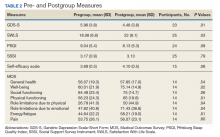Retreatment of Hepatitis C Infection With Direct-Acting Antivirals
Background: Treatment of hepatitis C virus (HCV) infection with direct-acting antivirals (DAAs) results in sustained virologic response (SVR) in > 90% of patients. However, some patients required retreatment with newer DAA options. Treatment was selected after consultation with a clinical pharmacy specialist.
Methods: A retrospective chart review of patients at the West Palm Beach Veterans Affairs Medical Center (WPBVAMC) in Florida retreated from January 2015 to December 2019 was conducted. Data collected included HCV genotype, previous therapy, newly prescribed medications, and treatment outcomes.
Results: Since 2015, > 900 patients have been treated at WPBVAMC, including 22 patients who had previously failed interferon combined with DAA regimens and 46 patients who needed retreatment after failure with an all-oral therapy. This review documents the outcomes of retreatment with DAA after initial failure to achieve SVR Of 28 patients treated with a boceprevir-based regimen, 10 ended in failure. All 10 were retreated, and all achieved SVR with ledipasvir/sofosbuvir. Of 53 patients treated with a sofosbuvir-based interferon regimen, 12 failed treatment. All 12 were retreated and all achieved SVR. Thirty patients were retreated after failure with an all-oral DAA. Of 27 tested, 21 achieved SVR. All patients who failed therapy again had cirrhosis.
Conclusions: Veterans retreated with DAAs for HCV infection had a high success rate. Repeat failures of DAAs were rare, but cirrhosis seems to be common among these patients.
Methods
A retrospective EHR review of patients retreated from January 2015 to December 2019 was conducted. Data collected included age, sex, HCV GT, previous therapy, new medications prescribed, creatinine clearance, and achievement of SVR12. This retrospective review was approved by the facility’s scientific advisory committee as part of performance improvement efforts. Descriptive statistics are provided.
Results
Boceprevir
We treated 31 patients with boceprevir of which 3 met futility rule and 28 completed therapy. Eighteen of 28 responded (64%) to the treatment. The 10 patients who failed treatment were retreated with LDV/SOF, and all achieved SVR.
Sofosbuvir
A total of 53 patients were treated with SOF, RBV, and pegIFN for 12 weeks. Forty-one achieved SVR (77%). Of the 12 who failed therapy, all have been retreated and achieved SVR (Table 2).
Interferon-Free DAA Oral Regimens
More than 900 patients have been treated with interferon-free regimens since 2015 and outcomes were documented for > 800 patients. The SVR rates by GT were as follows: GT1 639 of 676 (95%); GT2 76 of 79 (96%); GT3 40 of 48 (83%); and GT4 6 of 6 (100%). Eighty-four percent of patients had GT1 infection. The median age of patient was 62 years, 72% were treatment naïve, and 35% having cirrhosis (based on liver biopsy or FIB4 score).18
Of 48 treatment failures, 30 patients were retreated; the rest of the patients were lost to follow-up (n = 9) or unable to receive retreatment (n = 9) mainly due to decompensated cirrhosis or liver cancer and short life expectancy. The median age of patient in this retreatment group was 62 years, 62% had cirrhosis, and most were infected with GT1. The average creatinine clearance was 73 mL/min. Twenty-two patients who failed therapy with ledipasvir/SOF were retreated (Table 3). A total of 13 patients out of the 19 tested eventually achieved SVR (68%). Four of the patients who had treatment failure again had GT1 infection and the other 2 GT3. All had cirrhosis.
Thirty-five patients were treated with PrOD, and 32 achieved SVR (91%). All 3 patients were retreated. One patient each achieved SVR with ERB/GZP, SOF/VEL and SOF/VEL/VOX. Fifty patients were treated with ERB/GZP and 45 achieved SVR (90%). All 5 treatment failures were retreated. Four achieved SVR and 1 was lost to follow-up (Table 4). Overall, of 30 patients who were retreated after failure with an all-oral DAA regimen, 27 patients had SVR values available and 21 achieved it (78%).
Discussion
Overall SVR was very high for patients who received oral treatment for HCV infection. A low number of patients failed therapy and were retreated. Patients who failed therapy again were similar in age but were more likely to have cirrhosis when compared with the overall interferon-free treated group. Thus, prompt treatment after HCV detection and before disease progression may improve treatment outcomes. Achieving SVR has been shown to improve fibrosis, portal hypertension, splenomegaly and cirrhosis, and reduce the risk of hepatocellular carcinoma by 70% and liver-related mortality by 90%.19-21/







